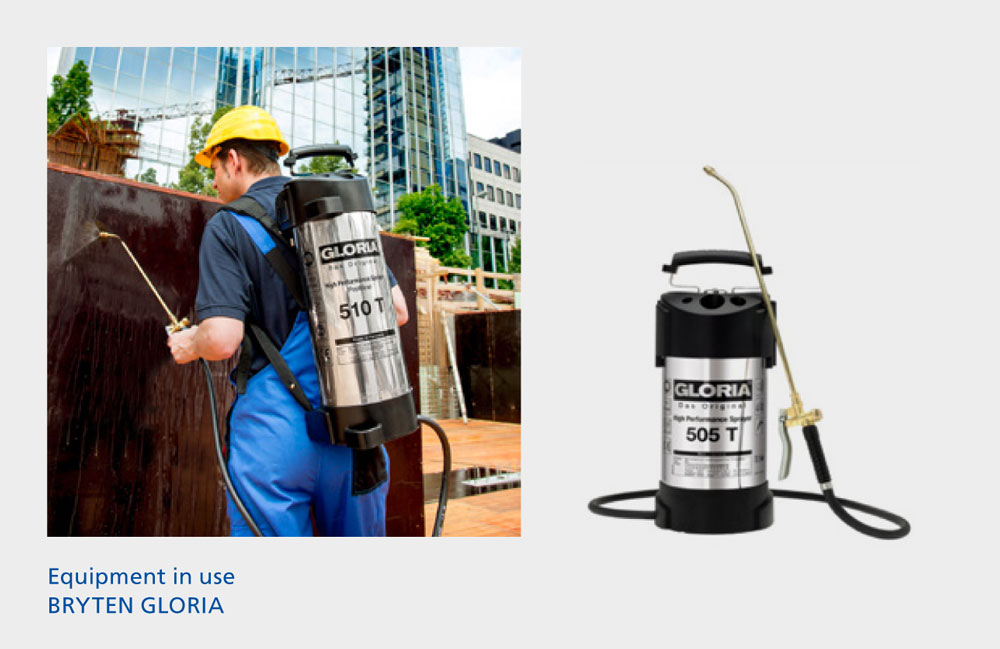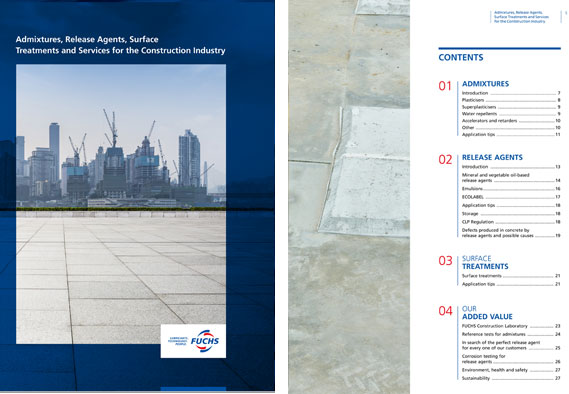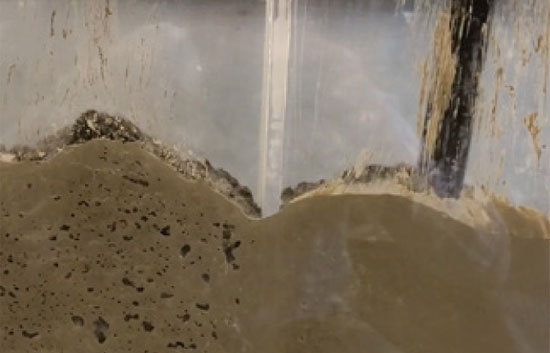Release Agents

Mineral oil-based release agents are specially recommended for precast plants and its structural and civil engineering. These products are for universal use. They are also used for immediate formwork stripping.
Vegetable oil-based release agents are often recommended for special uses or high quality finishes. They are typically used in precast plants on all common formwork: metal, plastic, chipboard and others. Some of these products can be used at formwork temperaturas up to 130 °C.
- Smooth, non-porous surfaces.
- Uniform, clean finishes.
- High protection against corrosión in Steel formwork.
- Good bonding of plaster, adhesives and paints.
- Suitable for use in vertical and horizontal moulds.
- Less fog formation. Greater safety for staff and the environment.
Release Agents
RENOCAST DES 6 | Mineral oil-based emulsifiable product especially suitable for formwork stripping of concrete, in both precast and in public works. |
RENOCAST DES 8 | Mineral oil-based emulsifiable product suitable for all types of moulds (wood, silicone and smooth metals). |
RENOCAST DES 20 | Low-viscosity mineral oil for precast concrete with metal, resin and concrete moulds. |
RENOCAST DES 20L | Low-viscosity mineral oil that protects moulds and extends their service life. |
RENOCAST DES 40 | Medium-viscosity mineral oil for all types of moulds, even with difficult shapes. |
RENOCAST DES 40L | Mineral oil-based release agent suitable for use in medium and large precast plants. |
RENOCAST DES 42 | Mineral oil to dilute with solvent or diesel, containing additives to protect moulds. |
Concrete mixers
RENOCAST DES HO | Non-stick release agent recommended for dry concrete production. |
RENOCAST DES TY | Non-stick release agent recommended for fluid concrete production. |
RENOCAST MIX 15 | Medium-viscosity, non-stick release agent for all production types. |
Special uses
RENOCAST DES DF | Product developed for turning machines and immediate formwork stripping. |
RENOCAST DES TM | Product for the manufacture of concrete tiles. |
RENOPAL 550 | Synthetic release agent for immediate mould release. |
Release Agents
RENOCAST DES 50 BI | Low-viscosity, odourless release agent recommended for the manufacture of panels. |
RENOCAST DES 50 BS | Low-viscosity release agent that can be used in heat-insulated processes. |
RENOCAST DES 55 | Release agent for all types of concrete and units. |
RENOCAST DES 57 | Medium-viscosity release agent for very high quality finishes. |
RENOCAST DES 58 AL | Vegetable oil with waxes for top quality finishes. |
Concrete mixers
RENOCAST MIX ECO | Universal and biodegradable protector. |
These can be used in precast plants and in all standard formwork, including metal sheet and phenolic film board. Compared to solvent release agents, emulsions have added advantages, particularly in terms of environment, health and safety.
FUCHS's R&D is focussed on the development of this type of product, which uses the latest technology and ensures better performance and finish.
It is recommended to apply this type of product by means of a spray system in order to ensure that the oil, containing its active ingredients, forms a uniform film over the formwork. When the release agent turns from white to colourless, it means that the water has evaporated, and the concrete can then be poured into the mould. The evaporation time depends largely on the ambient temperature, the lower the temperature, the longer the process will take.
All FUCHS emulsion release agents are supplied ready for direct use, without requiring dilution or any other previous preparation.
Main advantages:
- Biodegradable.
- No hazard labelling.
- Application temperature up to 70 °C (formwork temperature).
- Ready for direct use.
- Uniform, clean finishes.
- High protection against corrosion in steel formwork. Good bonding of plaster, adhesives and paints.
- Suitable for use in vertical and horizontal areas.
- Non-flammable.
Release Agents
RENOCAST DES EB 50 | Vegetable emulsion for all types of concrete, and in processes with heat-insulated moulds or steam-cured concrete. |
RENOCAST DES EB 55 | Low-viscosity release agent for all types of precast concrete where a smooth and defect-free surface finish is required. |
RENOCAST DES EB 60 | Vegetable emulsion, recommended for the manufacture of beams and units with complex shapes. |
RENOCAST DES EB 25 | Wax emulsion for architectural panels with top-quality glossy finishes. |
RENOCAST DES EB 30 | Low-viscosity wax emulsion for all types of moulds and top-quality finishes. |
Special uses
RENOCAST DES EB 59 | Vegetable emulsion developed for the production of self-compacting concrete. |
RENOCAST DES EB 53 | Vegetable emulsion for the production of sleepers. |
RENOCAST DES EB 75 | Release agent developed for wooden trays on block and paver machines. Contains additives that protect the wood. |
ECOLABEL is the official European Community eco- labelling system, whose purpose is to highlight products which, compared to conventional products, have reduced impact on the environment and therefore contribute to its protection and sustainable development. It is a simple and reliable way to help consumers identify the greenest, most environmentally friendly products and services.
The strict requirements imposed by the EU on the products to obtain this label, ensure:

- Reduction of water and soil pollution.
- Reduction of CO2 emissions.
- Their composition contains a high percentage ofrenewable raw materials.
- Limited use of hazardous substances (no R-phrases).
In order to contribute to an efficient use of resources and a high level of environmental protection, we promote our ECOLABEL construction products, which are free of solvents and hydrocarbons and highly biodegradable.
As an example of this, we present three of the release agents created by FUCHS for various uses in the construction industry: SOK ECO 107, BETONEX ECO and BITEEREX ECO.
SOK ECO 107 | For use in civil engineering and precast concrete plants. Ensures clean, uniform and pore-free surfaces. Universal use, in any type of mould or formwork |
BETONEX ECO | Universal protective release agent to prevent mortar and concrete from sticking to machinery, concrete transport trucks, concrete pumps, concrete mixers, silos, steel formwork and any type of metal part. High protection that helps reduce maintenance costs. Good resistance to water, effectiveness and durability. |
BITEEREX ECO | Bitumen release agent for hot and mastic asphalt. Universal use. Developed for application on rubber-roller compactors and used in tippers and vehicle beds transporting asphalt agglomerate to prevent it sticking. |
In order to optimize the use of release agents, obtain better finishes and protect the moulds, it is advisable to follow the following recommendations:
- Before applying the product, the mould must be dry and free of concrete, dust, rust and other dirt.
- Regardless of the application system, place a thin, homogeneous layer of release agent on the moulds, avoiding excess coating and sagging on vertical parts, with special attention to corners, crevices and other nooks and crannies.
- Remove excess coating with a sponge or rag dampened with the release agent itself before pouring the concrete. In the case of emulsions, excess coating is to be removed by the same method once the water has evaporated.
- It is advisable to use manual spraying (we suggest BRYTEN GLORIA equipment) or spray gun (with or without air). The recommended nozzles are conical and with a pressure between 2 atm and 5 atm.
- Pour the concrete into the mould after a suitable time has elapsed after the release agent has been applied: immediately in the case of pure oils; after 10 to 20 min in oils diluted with solvent and after 20 to 30 min in the case of emulsions, when the water has evaporated and the applied layer is transparent.

Storage
Release agents should always be stored in sealed containers, indoors and protected against freezing and direct sunlight.
CLP Regulation
From June 2015, mixtures of components must be classified according to the new hazardous substances legislation (GHS/CLP). Products based on hydrocarbons (mineral oil), if not otherwise required, are exempt from the CLP labelling regulation if they have a viscosity of more than 20.5 cSt at 40 °C.
Micro-pores on the surface of the concrete
Honeycomb appearance (1-2 mm in diameter). Mainly due to inadequate or poorly applied release agent (excess coating, concrete poured before time, etc.). Larger pores are due to concrete composition (lack of fines) or vibration problems.
Stains on the surface of the concrete
The yellowish-brown stains are due to excess release agent and are darker at the bottom of vertical moulds where the product accumulates.
Rust stains
Rust stains can appear due to the lack of corrosion protection of the release agent. They can also occur when using unprotected polished moulds.
Powdery surface of the concrete or chipping
This type of surface occurs when the formwork has been stripped too quickly or excess release agent has been applied. It can also happen where the concrete has been poured too early.
Lack of bonding of subsequent treatments (paint, plasters and others)
If the resulting surface is unduly smooth, this is an unmistakable sign that too much or too little product has been used. This can happen especially with release agents containing waxes.




